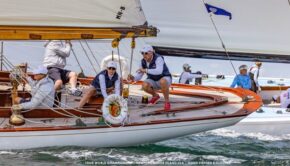Classic Ratings: Good and getting better
Published on May 9th, 2020
After becoming established as an organization in 2015, the Classic Yacht Owners Association (CYOA) formed a technical committee in 2016 to review the options on how to best handicap the classic yacht community.
Comparing CRF (Classic Rating Formula) with PHRF, Europe’s CIM, and an ORC VPP-based system, the group quickly recognized that current CRF ratings provide a reasonable reflection of the real world performance potential of some yachts within classes of similar sizes and types.
However, the committee also recognized there were notable exceptions, and as a means of addressing those shortcomings, they rolled up their sleeves and have continuously improved the system.
“While no ‘single number’ rule will ever be perfect, CRF is very good and getting better every year,” reports CYOA. The updates for 2020 include:
• A Standing Rigging Factor has been applied as an adjustment to effective sail area, to account for the competitive advantages of composite or stainless steel rod rigging over the wire common to most classic yachts.
• The Stability Correction that was first applied in 2019 has been refined using the ballast weight that is now required (it was requested in 2019 as part of a data gathering process, but not used in calculating 2019 ratings).
• The rated length of yachts with canoe sterns (“double enders”) has been reduced to account for the fact that effective sailing length is less than what is implied by declared waterline and overall profile lengths.
• CRF 2020 certificate applications require declarations for shroud type, ballast weight, Bm10 (only for hull dates >1990), design and build year, and a declaration of a canoe (or double ender) stern type if applicable.
• Measurements for mainsail and spinnaker girths (luff to leech widths) will be requested in CRF 2020 applications as a data gathering effort, but not used in calculating 2020 ratings. They will likely be used in calculating ratings for 2021. You can get these numbers from your sailmaker.
• CRF was fundamentally reworked in time for the 2017 racing season, and it has been referred to as ‘CRF MkII’ since. Going forward, it will be referred to as ‘CRF 2020’ in 2020, ‘CRF 2021’ in 2021, and so on. This change is for clarity, and to emphasize the fact that refinements and rating changes are routine and to be expected from one year to the next. CRF certificates must be renewed each year.
• Sail Material Guidelines have been updated for Vintage and Classic yachts. The guidelines, issued for Classic Regatta Organizing Authorities, encourage more uniformity from one regatta to the other. Each regatta has their own unique philosophies and traditions, and therefore may not adopt all CRF guidelines.
• Recommended CYOA Division Assignments will be displayed on each certificate and available on “For Organizing Authorities” guidelines.









 We’ll keep your information safe.
We’ll keep your information safe.